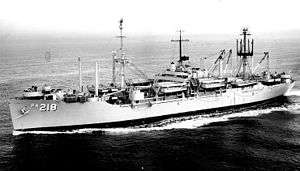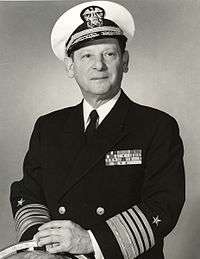Horacio Rivero, Jr.
| Horacio Rivero, Jr. | |
|---|---|
|
Admiral Horacio Rivero, Jr. First Puerto Rican and Hispanic four-star Admiral and second Hispanic to become a Full Admiral in the United States Navy | |
| Nickname(s) | Rivets |
| Born |
May 16, 1910 Ponce, Puerto Rico |
| Died |
September 24, 2000 (aged 90) Coronado, California |
| Place of burial | Fort Rosecrans National Cemetery, San Diego, California |
| Allegiance |
|
| Service/branch |
|
| Years of service | 1931–1972 |
| Rank |
|
| Commands held |
USS William C. Lawe (DD-763) USS Noble (APA-218) Amphibious forces, Atlantic Fleet Commander of Allied Forces in Southern Europe |
| Battles/wars |
World War II Korean War Cuban Missile Crisis Vietnam War |
| Awards |
Navy Distinguished Service Medal Legion of Merit Bronze Star with “V” |
| Other work | U.S. Ambassador to Spain |
Admiral Horacio Rivero, Jr. (May 16, 1910 – September 24, 2000), was the first Puerto Rican and Hispanic four-star Admiral, and second Hispanic to become a full Admiral in the modern United States Navy. David Glasgow Farragut (1801–1870), a Hispanic, became the first full admiral of the Navy during the American Civil War. After retiring from the Navy, Rivero served as the U.S. Ambassador to Spain (1972–1974), and was also the first Hispanic to hold that position.[1]
Early years
Rivero was born and raised in the city of Ponce, located in the southern coast of Puerto Rico, where he also received his primary and secondary education.
Military career
On June 20, 1927, he received an appointment from the Honorable Felix Cordova Davila, Puerto Rico's Resident Commissioner to attend the United States Naval Academy. His nickname "Rivets" came about in the academy as a result of an officer who had trouble reading Rivero's name on his uniform.[2] On June 4, 1931, he graduated third in a class of 441 from the U.S. Naval Academy in Annapolis, Maryland. Rivero's first assignment was aboard the USS Northampton (CA-26). From 1932 to 1936 he served aboard the following ships: USS Chicago (CA-29), USS New Mexico (BB-40), USS California (BB-44) and USS Pennsylvania (BB-38). He earned his Master's Degree in Electrical engineering from the Massachusetts Institute of Technology (MIT) in 1940 and in 1941 married Hazel Hooper.[3]
World War II

During World War II, he served aboard the USS San Juan (CL-54) as a gunnery officer and was involved in providing artillery cover for Marines landing on Guadalcanal, Marshall Islands, Iwo Jima, and Okinawa. For his service he was awarded the Bronze Star with Combat “V”. Rivero was reassigned to the USS Pittsburgh (CA-72). The Pittsburgh’s bow had been torn off during a typhoon and Rivero’s strategies saved his ship without a single life lost. For his actions he was awarded the Legion of Merit. He also participated in the Battle of the Santa Cruz Islands, the attack on Bougainville in the Solomons, the capture of the Gilbert Islands and a series of carrier raids on Rabaul. On June 5, 1945, Rivero was present during the first carrier raids against Tokyo during operations in the vicinity of Nansei Shoto.[1]
Rivero served as Assistant to the Assistant Chief of Naval Operations (Special Weapons) from August 1945 to February 1946. From February 1946 to June 1947 he served as a technical assistant on the Staff of Commander Joint Task Force One for Operation Crossroads, and was on the Staff of Commander, Joint Task Force Seven during the atomic weapons tests in Eniwetok in 1948.[4]
Korean War

After the war, Rivero commanded the USS William C. Lawe (DD-763) and during the Korean War the USS Noble (APA-218). Under his command, the Noble steamed to Korea to participate in the September Inchon amphibious assault. Thereafter, the Noble assisted in the transport of U.S. and foreign troops and equipment to and from the Korean combat zone. In July 1953, the Noble participated in Operation Big Switch, moving Communist North Korean prisoners from Koje Do to Inchon pursuant to the armistice agreement.[5]
Rivero studied nuclear weaponry at the National War College and in 1954 he became Assistant Chief of Staff for Naval Operations. In 1955, he was promoted to the rank of Rear Admiral and was a member of the Staff of the Commander in Chief, Western Atlantic Area.[1]
Between January 1958 and March 1959 he served as Commander Destroyer Flotilla One (COMDESFLOT ONE) headquartered in Yokosuka, Japan. [6]
Cuban Missile Crisis
The Cuban Missile Crisis was a tense confrontation between the Soviet Union and the United States over the Soviet deployment of nuclear missiles in Cuba. On October 22, 1962, Admiral Rivero, who served as Vice Chief of Naval Operations from 1961 to 1968, was the commander of the American fleet sent by President John F. Kennedy to set up a quarantine (blockade) of the Soviet ships in an effort to stop the Cold War from escalating into World War III. On October 28, Soviet Premier Nikita Khrushchev ordered the removal of the Soviet missiles in Cuba, and Kennedy ordered an end of the quarantine of Cuba on November 20, bringing an end to the crisis.[7][8] On July 31, 1964, Rivero became the first Puerto Rican, and first Hispanic to become a four-star Admiral in the modern era US Navy.
Vietnam War
During the Vietnam War, Rivero oversaw the day-to-day work of the Navy as the Vice Chief of Naval Operations. He was a stern supporter of a “brown-water navy,” or riverine force, on the rivers of South Vietnam.[1]
NATO commander
From 1968 until his retirement from the Navy in 1972, Admiral Rivero was the North Atlantic Treaty Organization's commander in chief of the Allied Forces in Southern Europe. He was responsible of the land, sea and air forces of five nations deployed in the Mediterranean area: Italy, Greece, Turkey, Britain and the United States. During his years as commander, there were some 215,000 of the 310,000 American troops in Europe stationed in West Germany. At the time, Rivero believed that any withdrawal of United States troops from West Germany might affect the strength of the United States Sixth Fleet in the Mediterranean.[2]
Post-Navy career
From 1972 to 1975 Admiral Rivero served as the U.S. Ambassador to Spain under the administration of President Richard M. Nixon from 1972 to 1974. Rivero was also the Honorary Chairman of the American Veterans’ Committee for Puerto Rico Self-Determination.[9] Admiral Horacio Rivero died on September 24, 2000 and was buried with full military honors in the Fort Rosecrans National Cemetery of San Diego, California. He was survived by a daughter, Mary Lynn Hogan; two grandchildren; two great-grandchildren, and two sisters, Sara and Lydia, both of Puerto Rico.[2] On November 11, 2008, the Government of Puerto Rico unveiled in the Capitol Rotunda the oil portrait of Admiral Horacio Rivero, Jr.
Awards and recognitions
Among Admiral Rivero's decorations and medals were the following:
|
|||
|
| ||
| Navy Distinguished Service Medal w/ two gold stars | Legion of Merit | ||
| Bronze Star w/ valor device | Asiatic-Pacific Campaign Medal | World War II Victory Medal | National Defense Service Medal w/ one bronze star |
| Korean Service Medal | Vietnam Service Medal | United Nations Service Medal | Vietnam Campaign Medal |
Further reading
- "Puertorriquenos Who Served With Guts, Glory, and Honor. Fighting to Defend a Nation Not Completely Their Own"; by : Greg Boudonck; ISBN 1497421837; ISBN 978-1497421837
See also
- Hispanic Admirals in the United States Navy
- List of famous Puerto Ricans
- Puerto Ricans in World War II
- List of Puerto Rican military personnel
- List of Korean War veterans who are recipients of the Bronze Star
- Hispanics in the United States Navy
- Hispanics in the United States Naval Academy
References
- 1 2 3 4 Barry Leonard, ed. (1997). Hispanics in America's Defense. Darby, PA: Diane Publishing Company. pp. 88–89. ISBN 0-7881-4722-6.
- 1 2 3 Pace, Eric (September 28, 2000). "Adm. Horacio Rivero Jr., 90, Vice Chief of Naval Operations". New York Times. Archived from the original on 2011-09-20. Retrieved May 4, 2010.
- ↑ "Papers of Vice Admiral Horacio H. Rivero, 1945-1972". Washington, D.C.: Operational Archives Branch, Naval Historical Center.
- ↑ "Noble". Dictionary of American Naval Fighting Ships (DANFS). Washington, D.C.: Naval Historical Center, Department of the Navy. Retrieved March 16, 2009.
- ↑ Personal experience of Michael Newman, PH2, USN, as COMDESFLOT ONE photographer, January 1958 to March 1959
- ↑ "Profile of Horacio Rivero". Puerto Rico Herald. February 25, 2000. Archived from the original on 2005-11-02. Retrieved 2006-10-03.
- ↑ Barlow, NHC 2003.
- ↑ "Our Leadership". American Veteran's Committee for Puerto Rico Self-Determination. Retrieved 2006-10-21.
- Robert F. Dorr (January 26, 2004). "Damn the Torpedoes! Former VCNO excelled in combat, technical roles [Horacio Rivero Jr]". Navy Times. Archived from the original on 2004-01-21. Retrieved 2006-10-21.
Further reading
- "Hispanics in America's Defense" by Diane Publishing Company; Pages 88–89; Published 1997; ISBN 0-7881-4722-6
- Jeffrey G. Barlow (22 September 2003). "Some Aspects of the United States Navy's Participation in the Cuban Missile Crisis". Colloquium on Contemporary History. Naval Historical Center, United States Navy. Retrieved 2006-10-21.
External links
- American Veteran's Committee for Puerto Rico Self-Determination. Retrieved 2006-10-21.
- "Index to Politicians". The Political Graveyard. Retrieved 2006-10-21.
- "Honoring Admiral Horacio Rivero". La Casa de Puerto Rico, San Diego. Retrieved 2006-08-17.
- "Ambassadors to Spain". United States Department of State.
| Diplomatic posts | ||
|---|---|---|
| Preceded by Robert C. Hill |
U.S. Ambassador to Spain 1972–1974 |
Succeeded by Wells Stabler |
